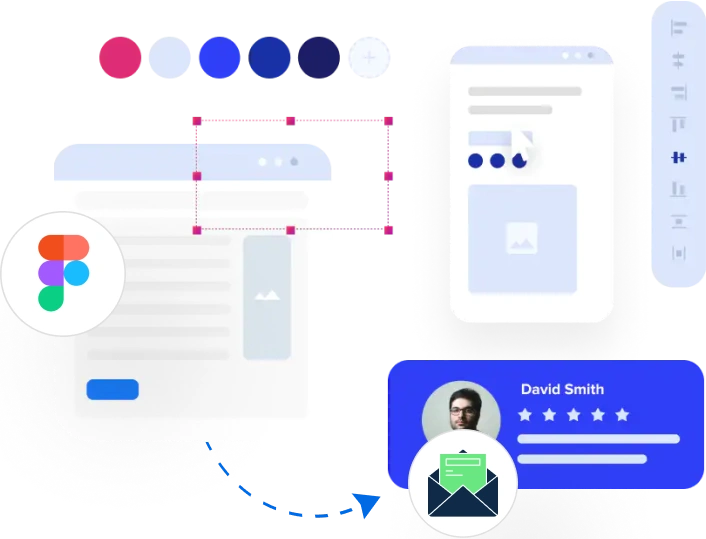PixelCrayons delivers rapid conversion of your Figma email designs to functional HTML, reducing your template development time by an average of 25%. Our process guarantees inbox-ready emails that maintain design integrity and improve campaign effectiveness.
Transform your Figma designs into eye-catching email templates that adjust perfectly across all devices. Our development team ensures pixel-perfect conversion while maintaining brand aesthetics for maximum impact and engagement.
Clean, optimized HTML code for your email campaigns maximizes deliverability and performance. We reduce file sizes and implement best practices that improve inbox placement and ensure your messages reach their destination.
Connect your email templates with popular platforms like Mailchimp, HubSpot, and Salesforce. We handle the technical integration work so you can focus on creating effective marketing campaigns without compatibility headaches.
Enhance email functionality with specialized interactive modules tailored to your unique needs. Our developers craft custom elements that make your emails stand out, from countdown timers to interactive product galleries.
Future-proof your emails with dark mode support that adapts automatically to user preferences. We implement specialized code that ensures your branding remains consistent whether viewed in light or dark environments.
Keep email templates fresh and functioning perfectly with regular updates and technical maintenance. Our team monitors changing email client standards to ensure your templates perform flawlessly across all platforms.
Let us turn your Figma designs into responsive email templates that work seamlessly across all devices and email clients.

Our Figma to Email Template conversion services are tailored to help businesses turn their Figma designs into high-quality, responsive email templates
that engage customers and drive results.
Boost your email marketing and send clean, responsive templates to your clients with help from PixelCrayons. Our experienced team converts your Figma designs into fully working email templates that work well across major email platforms. You get more time to focus on growth while we manage the technical side.

Make the email template conversion process easier for your clients with PixelCrayons. Whether your project is big or small, our expertise can handle large-scale email template conversions. Our team ensures each template is both responsive and pixel-perfect. We optimize for all email clients, ensuring strong brand identity across campaigns.

Enhance your digital marketing services by offering your clients customized, responsive email templates. PixelCrayons converts Figma designs into HTML email templates fully optimized for mobile and desktop. With our help, you can provide your clients professional, engaging emails that improve open rates and drive conversions.

We convert Figma to HTML email templates with a high-performance system designed for scale.
Our coders work with reusable code blocks, mobile-first logic, and automated QA reports. This enables faster production, campaign consistency, and performance-ready templates that reduce operational delays and marketing costs.

Our Figma to email template conversion service ensures your templates are both functional and visually appealing to increase open rates.
There are specific things you should prepare before you convert your Figma design into email HTML. Here’s a clear overview of what to check before you begin.
![]()
Converting Figma designs into email templates is a structured process that ensures the final product is responsive, functional, and compatible with different email clients. Here is a simple breakdown of how the process works:
1. Design Assessment & Preparation
Before starting, it’s crucial to review the Figma design carefully. The design must be clear, with proper spacing, fonts, and image specifications. During this step, the following happens:
2. Slice & Export Design Elements
Next, we extract the necessary design assets from Figma. This involves:
3. Writing the HTML Structure
Once the assets are prepared, the next step is to create the HTML code. The process includes:
4. Testing & Quality Assurance
Testing the email template is critical. It helps ensure that the template renders correctly across different platforms and devices. The key tasks during this phase include:
5. Final Adjustments & Delivery
Finally, before delivering the email template, we make any last-minute tweaks and ensure:
By following these steps, you ensure that your Figma design turns into a fully functional, responsive email template ready to engage your audience.
![]()
Creating the right email template for your business means focusing on design, functionality, and cross-platform compatibility. It should meet your marketing goals and provide a seamless user experience.
1. Clean & Simple Layout
A clean layout is essential for any email template. A clutter-free design ensures your message is clear and easy to read. The key is to keep it simple while highlighting important details.
Here are some elements to consider:
2. Mobile-Friendly Design
More than half of all emails are opened on mobile devices, so your email template must adapt well to different screen sizes. A responsive design adjusts content to look good on desktop and mobile screens.
Key tips for a mobile-friendly design:
3. Branding Consistency
Consistency in branding is crucial for recognition. Your email template should reflect your brand’s style, colors, and voice. This ensures the email feels familiar and reinforces brand identity with each campaign.
Here’s what to include:
4. Clear Call-to-Action
A strong call-to-action (CTA) tells the reader what to do next. It’s essential for conversion. Make sure it stands out whether it’s a sign-up button or a product link.
Consider these tips:
5. Cross-Platform Compatibility
Lastly, ensure that your email template works across all platforms and email clients. Not every email client handles designs the same way, so it’s important to test and tweak for compatibility.
Things to keep in mind:
A business-ready email template is a mix of good design, functionality, and adaptability. With these key elements in mind, you can ensure your emails reach and engage your audience effectively.
Email design is more than just choosing colors and placing buttons. For many businesses, it’s about getting things done faster, collaborating better, and keeping everything consistent. That’s why Figma stands out. It helps teams design, test, and hand off email templates in one place.
1. Works Well for Remote Teams
Many teams today work across different cities or countries. Figma makes it easy for everyone to stay on the same page. Designers, marketers, and developers can work together without sending files back and forth.
Here’s what makes Figma great for team collaboration:
2. Keeps Email Designs Consistent
Businesses need their emails to look the same across campaigns. Figma helps set clear design rules. Teams can create a shared design system to make sure fonts, buttons, colors, and spacing stay the same in every email.
With design systems in Figma, you can:
3. Speeds Up the Review & Handoff
Once the design is ready, Figma makes it easy to pass it to developers or email builders. You don’t need to explain every little thing.
Here’s how Figma makes handoff simple:
If you’re running email campaigns, you already know how much design impacts clicks and conversions. But designing emails in Figma alone isn’t enough. Converting those designs into working email templates is where the real results come from.
This one step turning Figma into a code-ready email can make your email marketing faster, more effective, and more consistent. Let’s break down how that happens in a real business setup.
1. You Avoid Inconsistencies Between Design & Code
When design and code don’t match, emails break. Fonts, colors, and layouts may look different in the inbox than in Figma.
Converting Figma files properly avoids that mismatch. Developers get exactly what the designer intended. So every button, space, and line shows up just as planned.
Here’s what it helps with:
2. You Save Time During Email Production
Without a proper hand-off, teams waste hours adjusting layouts manually.
Figma to HTML conversion cuts that waste. Your designer finishes the layout, and the code is built from that, without redoing things from scratch.
This means:
3. You Get Reusable, Modular Email Templates
Once a Figma design is converted, the final email can be broken into components.
That helps teams reuse parts like headers, buttons, and sections in future emails.
Why this matters:
4. You Minimize Errors in Live Emails
Copy-pasting design ideas or rebuilding layouts often leads to broken sections.
Converting directly from Figma keeps the structure intact, so fewer things go wrong in the final output.
This avoids:
5. You Stay Consistent Across All Devices & Email Clients
What looks good in Gmail might not work in Outlook.
Figma to email conversion ensures emails are coded with compatibility from the start.
That brings:
If you’re planning to convert your Figma design into an email, the file must be clean, complete, and easy to follow. Otherwise, the email might not look or work the way you expect.
Think of your Figma file as the blueprint. If it has missing or messy parts, the developer won’t know what to build or how to build it. So, before you share the design for email conversion, here are five must-haves you should always include.
1. A Clear Layout With Defined Sections
Make sure your design is neatly organized. Each section of your email should be easy to identify.
Here’s what that means:
This helps the developer know what goes where without making guesses.
2. Desktop & Mobile Versions
Emails need to look good on all devices. That includes mobile phones, tablets, and desktops.
So remember to include:
Don’t rely on assumptions. Show both versions.
3. Actual Text Layers Instead of Outlined Fonts
Don’t convert text into shapes or outlines. Developers need real text to make the email readable and editable later.
Make sure:
If the text is outlined, it becomes an image, which can’t be copied or edited.
4. All Image Assets in Correct Sizes
Email conversion needs real image files. These should match your design in size and quality.
Before sharing the file, double-check:
If the developer doesn’t get proper assets, the email may look broken.
5. Notes on Interactions & Link Areas
Emails don’t have fancy animations, but they do have links, hover colors, or image rollovers. These must be clearly marked in your design.
Add notes that explain:
This saves time and avoids back-and-forth on what’s supposed to work as a link.
![]()
Turning your Figma designs into HTML email templates is not just about code. It’s about accuracy, compatibility, and speed. If you pick the wrong service provider, your emails may not load correctly. They may look broken on mobile. Or worse, they might land in spam. This is why you need to choose carefully.
Start by looking at their past work. Don’t go by brand name alone. See how well they convert Figma to email. Make sure the emails look exactly like the original Figma files. Also, test them on different devices.
Here’s what you should look for when choosing someone to convert Figma designs into HTML email:
1. Pixel-perfect HTML output
The email should match your Figma design 100%. No spacing issues. No missing icons. No broken layouts.
2. Mobile responsiveness
Make sure they test across devices. The email must look good on mobile, tablet, and desktop.
3. Compatibility across email clients
Some providers skip testing in Outlook or Yahoo Mail. Don’t ignore this. Ask how they ensure support across major clients.
4. Turnaround time
Delays in email HTML can affect your campaign. Know their delivery time upfront.
5. Support for interactive elements
If your Figma design has buttons or sections that expand, ask if they can code it with fallback for email clients.
6. Clean code and inline CSS
The way they convert Figma to HTML email templates matters. Code must be clean, inline-styled, and free of unnecessary scripts.
Questions to Ask Before Hiring
Before you hand over your Figma file, ask these questions:
Choosing the right partner can save you many hours of rework. It ensures your Figma to HTML email templates go live on time and look right everywhere.
Not sure how our Figma to email conversion process works? These answers will help you understand what to expect before moving forward.
Yes. We convert Figma to email templates with clean, table-based HTML that adapts to all major devices. Even complex layouts are coded to work well in email clients. We make sure your original design stays intact and renders correctly across platforms.
Absolutely. Our Figma to email template conversion service ensures that the final email is:
We focus on functionality without compromising design fidelity.
Yes, we make sure your email templates are compatible with all major platforms. Whether you use Mailchimp, HubSpot, Campaign Monitor, or others, our Figma to email template files are ready for direct integration.
You can share the Figma file directly through a view-only or edit-access link. We work within the live Figma environment, so no exports are needed. This keeps the handoff clean and avoids layout shifts.
Minor changes are usually covered in the initial phase. If you have structural updates or new elements, we offer:
We make it easy to get your final Figma designs to email HTML ready for launch.
Yes, we specialize in large-scale Figma to email template conversion. Whether the project involves 50 or 500 templates, we assign dedicated developers and QA experts to ensure consistent quality, fast delivery, and structured communication throughout the project.
Costs vary depending on design complexity and total template volume. Factors that affect pricing include:
We provide clear estimates after reviewing your Figma to email conversion scope.
Let us show you how our digital services can drive your success.